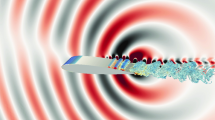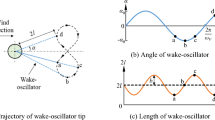Abstract
The aeroacoustic characteristics of a helicopter rotor are calculated by a new method, to assess its applicability in assessing rotor performance in hovering. Direct solution of the Euler equations in a noninertial coordinate system is used to calculate the near-field flow around the spinning rotor. The far-field noise field is calculated by the Ffowcs Williams–Hawkings (FW–H) method using permeable control surfaces that include the blade. For a multiblade rotor, the signal obtained is duplicated and shifted in phase for each successive blade. By that means, the spectral characteristics of the far-field noise may be obtained. To determine the integral aerodynamic characteristics of the rotor, software is written to calculate the thrust and torque characteristics from the near-field flow solution. The results of numerical simulation are compared with experimental acoustic and aerodynamic data for a large-scale model of a helicopter main rotor in an open test facility. Two- and four-blade configurations of the rotor are considered, in different hover conditions. The proposed method satisfactorily predicts the aerodynamic characteristics of the blades in such conditions and gives good estimates for the first harmonics of the noise. That permits the practical use of the proposed method, not only for hovering but also for forward flight.
Similar content being viewed by others
References
International Standards and Recommended Practics. Application 16 to Convention on International Civil Aviation. Environmental Protection. Vol. 1. Aviation Noise. (ICAO, 2011).
Technical Guidelines on Environmental Medium. Vol. 1. Methods of Air Ship Sertification on Noise (ICAO.doc 9501-AN/929, 2010).
S. A. Karabasov, Matemat. Modelir. 18 (2), 3–23 (2006).
D. A. Boxwell, F. H. Schmitz, W. R. Splettstoesser, and K. J. Schultz, J. Am. Helicopt. Soc. 32 (1), 3–12 (1987).
F. H. Schmitz, E. Greenwood, R. D. Sickenberger, G. Gopalan, B. W.-C. Sim, D. A. Conner, E. Moralez, and W. Decker, in Proc. Am. Helicopter Soc. 63rd Annu. Forum, (Virginia Beach, VA, 2007).
V. F. Kopiev, M. Y. Zaitsev, N. N. Ostrikov, S. L. Denisov, S. Y. Makashov, V. A. Anikin, and V. V. Gromov, Acoust. Phys. 62 (6), 741–746 (2016).
S. A. Karabasov and T. P. Hynes, Proc. Inst. Mech. Eng. Pt. C: J. Mech. Eng. Sci. 220 (2), 185–202 (2006).
T. L. Holst, J. Aircraft 25 (12), 1073–1087 (1988).
M. A. Lavrentiev and B. V. Shabat, The Methods of Complex Variable Function Theory (Nauka, Moscow, 1973) [in Russian].
Author information
Authors and Affiliations
Corresponding author
Additional information
Original Russian Text © V.F. Kopiev, M.Yu. Zaytsev, V.I. Vorontsov, S.A. Karabasov, V.A. Anikin, 2017, published in Akusticheskii Zhurnal, 2017, Vol. 63, No. 6, pp. 651–664.
This paper is based on materials presented at the Sixth Russian Conference on Computational Experiments in Aeroacoustics (September 19–24, 2016, Svetlogorsk, Kaliningrad Oblast), http://ceaa-w.imamod.ru.
Rights and permissions
About this article
Cite this article
Kopiev, V.F., Zaytsev, M.Y., Vorontsov, V.I. et al. Helicopter noise in hover: Computational modelling and experimental validation. Acoust. Phys. 63, 686–698 (2017). https://doi.org/10.1134/S1063771017060070
Received:
Published:
Issue Date:
DOI: https://doi.org/10.1134/S1063771017060070




